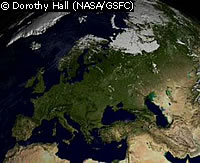New research points to larger role for nature in climate change
A new study of climatic conditions in the northern hemisphere over the last 2,000 years has led scientists to increase their estimates of the impact of natural climate change on the Earth's overall climate. Currently, the most widespread view of climate variability during the past millennium is one of only minor changes before 1900, at which point a period of marked warming began. However, the latest study reveals a prolonged heat wave in the northern hemisphere during the 11th and 12th centuries, followed by a pronounced cold period around 1600. The research was carried out by scientists from Stockholm University in Sweden, led by Anders Moberg, in collaboration with colleagues in Russia. The study analysed indirect climate data from sources such as ocean and lake floor sediment cores, ice sheet cores, cave stalagmites and tree rings. The real difference between this and previous studies, however, was the application of a new mathematical model, called wavelet analysis, to the data. Their results, published in the Nature scientific journal, show that the temperature swing during this 500 to 600 year period was around 0.65 to 0.9 degrees Celsius, which is huge in terms of the potential effect on the planet's climate, say the researchers. The closest that previous analyses had come to this figure was a swing of around 0.5 degrees. Climatologists suspect that the causes of such temperature swings are small fluctuations in the Earth's orbit and wobbles in its movements around its axis, as even minor changes to either can dramatically affect the planet's exposure to the heat of the Sun. Large volcanic eruptions may have also played a role by releasing huge quantities of the greenhouse gas carbon dioxide. However, these latest findings do little to improve our understanding of the impact of human activities of climate change. The team admits that it is difficult to distinguish the human influence on climate from such natural variability, yet the researchers stress that the last two decades of warm weather are best explained if one includes human activities in the simulations. One thing that this latest research has clearly underscored, however, is the importance of including natural climate variability when developing future scenarios and models.
Countries
Russia, Sweden



